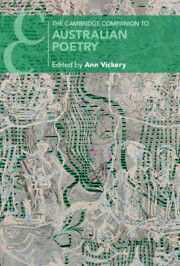Book contents
- The Cambridge Companion to Australian Poetry
- The Cambridge Companion to Australian Poetry
- Copyright page
- Contents
- Figures
- Contributors
- Acknowledgements
- Chronology
- Introduction
- Part I Change and Renewal
- Part II Networks
- Part III Authors
- Part IV Embodied Poetics
- Part V Expanding Form
- Further Reading
- Index
- Cambridge Companions To …
- References
Introduction
Published online by Cambridge University Press: aN Invalid Date NaN
- The Cambridge Companion to Australian Poetry
- The Cambridge Companion to Australian Poetry
- Copyright page
- Contents
- Figures
- Contributors
- Acknowledgements
- Chronology
- Introduction
- Part I Change and Renewal
- Part II Networks
- Part III Authors
- Part IV Embodied Poetics
- Part V Expanding Form
- Further Reading
- Index
- Cambridge Companions To …
- References
Summary
The new millennium has witnessed a resurgence in poetry as its condensed form, attention to feeling, and capacity to capture the zeitgeist attracts more readers than ever before. Australia has been at the forefront of experimenting with emergent and hybrid forms such as the verse novel, prose poetry, digital poetries, and poetic biography. Among the first to realise the potential of the Internet to create a vibrant cross-cultural dialogue around poetry and poetics, Australians initiated online journals that reached out globally like Jacket and Cordite Poetry Review. Australia’s poets have increasingly garnered international recognition. Les Murray was dubbed “one of the superleague that includes Seamus Heaney, Derek Walcott and Joseph Brodsky” by the Independent on Sunday (quoted in Davie) while Dan Chiasson discerned in The New Yorker that Murray was “routinely mentioned among the three of four leading-English language poets.” In 2017, Australian poet Ali Cobby Eckermann was the first Indigenous writer worldwide to be awarded Yale University’s prestigious Windham Campbell Prize.
- Type
- Chapter
- Information
- The Cambridge Companion to Australian Poetry , pp. 1 - 18Publisher: Cambridge University PressPrint publication year: 2024



